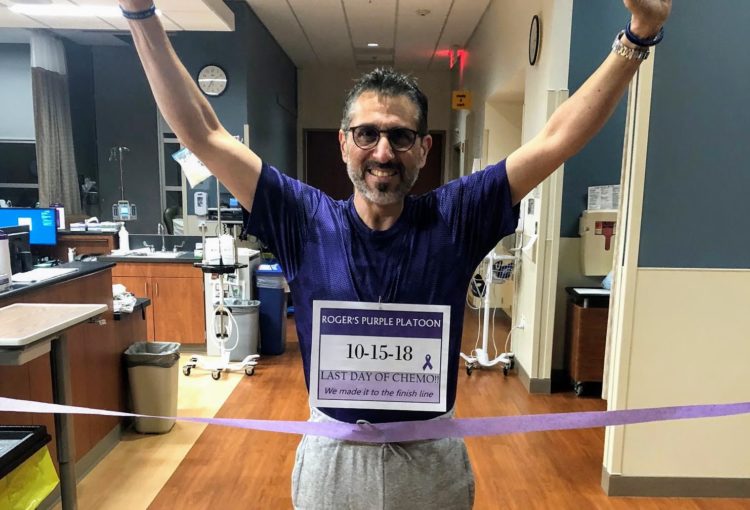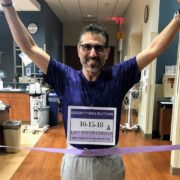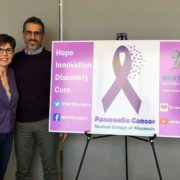ROGER CAPLINGER
Milwaukee Brewers Medical Director Handled a Pancreatic Cancer Curveball
Written By Julia Brabant
November 2021
Date of Diagnosis: December 1, 2017
Current Status: No signs of active cancer
Covering the Bases: How The Milwaukee Brewers Medical Director Roger Caplinger Faced The Fight To Strike-Out Pancreatic Cancer
As Medical Director for Major League Baseball’s Milwaukee Brewers, Roger Caplinger performs his best work behind the scenes, rather than behind the plate – but a 2017 pancreatic cancer diagnosis made him an increasingly public face in the fight to strike out the deadly disease.
As a longtime medical professional, Roger wasn’t one to “wait and see” when he started noticing unusual changes in his health. When his symptoms ranged from increasingly severe stomach pain to dark, discolored urine, he sought prompt medical treatment.
Lab tests revealed that his bilirubin levels and liver function test results were off the charts, prompting doctors to conduct a CT scan. Thinking Roger’s symptoms might be the result of gallstones, his primary care physician, Dr. Mark Niedfeldt, moved forward with an MRI.
By December of 2017, Roger, his wife, Jackie, and their two boys, Kyle and Brett, found out that his doctors suspected pancreatic cancer. Roger soon learned that Dr. Douglas B. Evans, M.D., F.A.C.S., one of the world’s premier pancreatic cancer specialists and researchers at the nearby Medical College of Wisconsin in Milwaukee, would take his case.
Dr. Evans and other members of Roger’s medical team, among them Dr. Susan T. Tsai, M.D., Dr. Beth A. Erickson, M.D., F.A.C.R., F.A.S.T.R.O, and Dr. Paul S. Rich, M.D., started Roger on an intense, six-week regimen that involved radiation five times weekly and chemotherapy once weekly. At first, his body adjusted and reacted well, but Dr. Erickson warned him that many patients hit roadblocks after week three.
“She was right on,” Roger acknowledged. His care team gave his body a six-week break at the conclusion of radiation and chemo before scheduling his next step: surgery.
“Dr. Evans is an unbelievable technical surgeon,” Roger said, noting that the Whipple may be the most invasive, intensive abdominal surgery performed in modern medicine. “I was 50 and relatively healthy before all of this – I don’t know how so many people go through it in their 70s.”
Recovery was rough, and he soon started experiencing low-grade back pain. He again sought treatment.
“What you don’t know, you can’t fix,” Roger said. “Dr. Evans knew he could count on me to come in and tell him everything I knew and was feeling.”
It turned out his pancreas had begun to leak. After several diagnostic tests, two drains were placed in the areas of the surgically repaired pancreas to allow healing to take place. Additional review by Roger’s care team had doctors recommending he consider what would be the first of several clinical trials aimed at both treating patients and advancing pancreatic cancer research.
At first, Roger was resistant to enrolling in the clinical trial. At his wife’s urging, though, he moved forward.
“What if you don’t do the trial, and then the cancer comes back?” She’d asked. “We should also do this trial and help other pancreatic cancer patients.”
With that in mind, Roger also enrolled in an IIT-TSAI-META-KAROC-REV2 clinical trial that explored whether doxycycline, which works as an acne antibiotic in mice, would help stimulate cancer stem cells.
In addition to participating in clinical trials, Roger underwent testing to see if he had any chromosomes or genetic markers that predisposed him to pancreatic cancer, or cancer in general. He thought something might appear on the tests because he was an otherwise healthy man who had no known family history, wasn’t overweight and didn’t smoke or drink heavily. Yet, the tests showed no obvious predispositions.
He also dropped 50 pounds after his diagnosis and hired a nutritionist to help him figure out how to adjust to his new dietary needs. Roger could no longer tolerate much of the fat content in foods and needed to adjust how he fueled himself by adding protein to his diet.
While Roger has reached a point in his battle where he might be able to return for follow-ups on an annual basis, he chooses to instead have them every four months. He recognizes how lucky he is to that his Major League Baseball health insurance helps make this feasible, and he also notes how grateful he is for the work of Dr. Evans, going so far as to secure the doctor an autographed jersey from his all-time favorite player, Carl Yastrzemski, a former leftfielder and first basemen for the Boston Red Sox.
He also noted how much one of his early interactions with Dr. Evans shaped his perspective moving forward. He recalled the day one of Dr. Evans’ nurses, Gabby, told him, “The boss wants to see you.”
Feeling like he was on his way to the principal’s office, Roger instead found a five-year pancreatic cancer survivor, Kelley, sitting alongside the doctor in his office; a woman whose pancreatic cancer was almost identical to Roger’s.
“This is you in five years,” Dr. Evans had said.
Roger also calls his wife, Jackie, his biggest cheerleader, noting that caregivers deserve the same degree of support and applause as doctors. He said that, since his diagnosis, he and his wife have also become supporters of Kathy’s House, a nonprofit that provides housing to out-of-town cancer patients undergoing treatments in Milwaukee and their caregivers.
Roger also recalled how his wife and sons showed up during one of his treatments with brand-new tattoos bearing the phrase, “Battle Ready.” Supplied by their friend and colleague, Bryson, the family had begun to use it as a mantra during Roger’s treatments, and they now had it tattooed in Roger’s handwriting on the inside of their wrists. Originally resistant to tattoos, Roger’s left wrist now bears it, too.









I’ve known Roger caplinger since he was a little boy. So glad to hear that he has done so well, has a great family and made it through this cancer scare. Good on ya dude!
Edie
Thank for that comment on Roger. Not sure there is a finer human being on the planet. So happy to call him my friend!
Roger